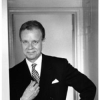Martin Filler

Martin Filler
Martin Myles Filleris a prominent American architecture critic. He is best known for his long essays on modern architecture that have appeared in The New York Review of Books since 1985, and which served as the basis for his 2007 book Makers of Modern Architecture, published by New York Review Books...
NationalityAmerican
ProfessionCritic
Date of Birth17 September 1948
CountryUnited States of America